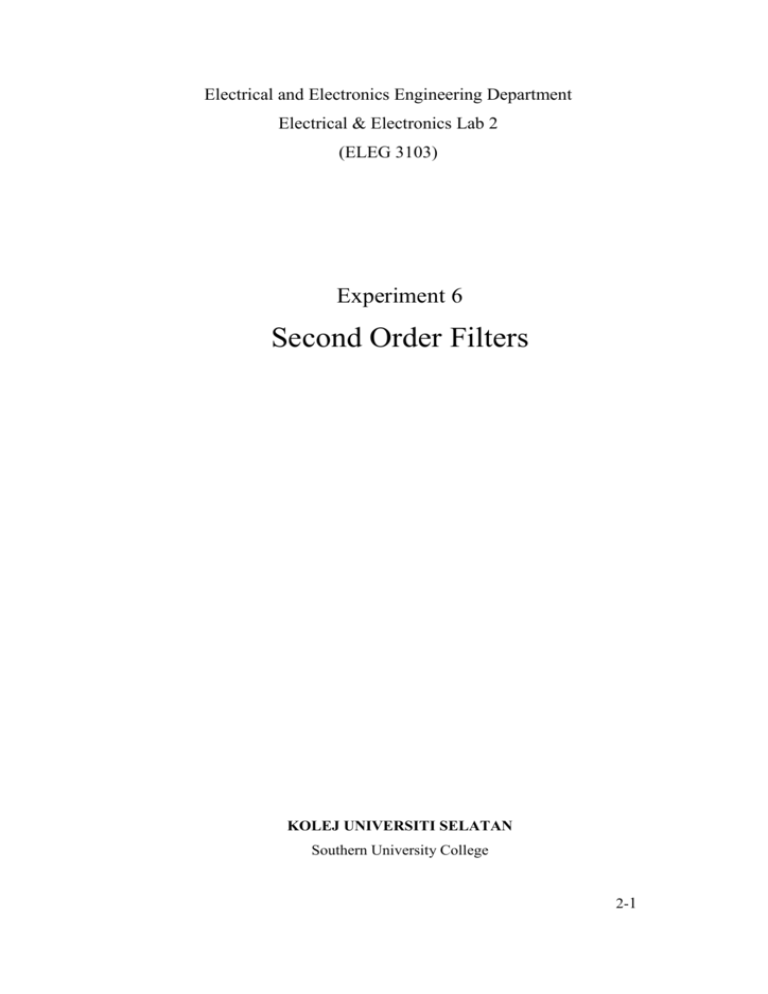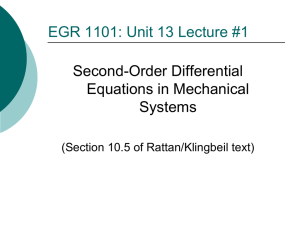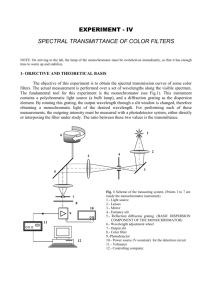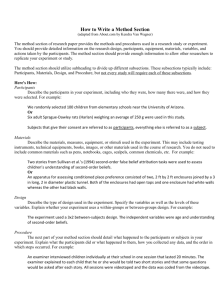EELab2_Exp6_Second_Order_Filter 492KB Nov 12 2014 06:34
advertisement

Electrical and Electronics Engineering Department Electrical & Electronics Lab 2 (ELEG 3103) Experiment 6 Second Order Filters KOLEJ UNIVERSITI SELATAN Southern University College 2-1 Objectives Understanding the characteristics of filters. Understanding the advantages of active filters. Implementing second-order filters with integrator circuit. Introduction Filters, which exist t every w here in communication systems, are designed to pass a specified band of frequencies while attenuating all signals outside this band. Filters are usually classified according to filtering range, frequency response in pass band, and circuit component. Classified by filtering range, there are four types of filters: low-pass, high-pass, band-pas s, and band-reject filters. Ac cording to frequency response in pas s band, there are two types: Butterworth and Chebyshev filters. According to circuit component, they are active and passive filters. Passive filters are the circuits ts that c contain only passive components (resistors, inductors and capacitors) connected in such a way that they will pass certain frequencies while rejecting others .Active filters, which are the only type covered in this chapter, employ active components (transistors or operational amplifiers) plus resistors, inductors and capacitors. Active filters are widely used in modern communication systems, because they have the following advantages: 1. Because the transfer function with inductive characteristic can be achieved by particular circuit design, resistors can be used instead of inductors. 2. The high input impedance and low output impedance of the operational amplifier means that the filter circuit is excellent in isolation characteristic and suitable for cascade. 3. Because active components provide amplification, therefore active filters have gain. In the following sections, we will focus on the characteristics of the second-order low-pass and high-pass active filters. 2-2 Second-Order Low-Pass Filter: A low-pass filter is an electronic circuit that has a constant output voltage from dc up to a cutoff frequency. As the frequency increases above the cutoff frequency, the output voltage is attenuated. The cutoff frequency, also called the 0.707 frequency, the 3dB frequency, or the corner frequency, is the frequency where the output voltage is reduced to 0.707 times its pass band value. A typical active low-pass filter circuit, shown in Fig. 2-1, is commonly called inverting integrator or Miller integrator. Its transfer function can be expressed b (2-1) Where Fig. 2- 1 Miller Integrator 2-3 F i g.2-2 Block diagram of a second-order low -pass filter From Eq. (2-1), we can find that t he Miller integrator circuit is a first order low-pass filter Therefore, a second-order low-pass filter can be easily constructed by cascading two Miller integrators with an inverting amplifier. The block diagram of second-order low-pass filter, shown in Fig. 2-2 is consisted of two Miller integrators, a unity-gain inverting amplifier and adder. Therefore, the transfer function is (2-2) This is a general form of second-order low-pass filter. Following this block diagram, a practical second-order low-pass filter is indicated in Fig. 2-3. In this circuit, the operational amplifier U1: A performs the functional combination of the adder and the first Miller integrator in Fig. 2-2. If The transfer function will be (2-3) Comparing Eqs. (2-2) to (2-3), we yield 2-4 ( 2-4 ) (2-5) (2-6) In the circuit of Fig. 2-3, the components R, R2, R3, C1 and U1:A form the Miller integrator with the function of weighted adder. The adder is used to add the input signal to the feedback signal from the U1:C output. The combination of R4, C2 and U1:B is the second miller integrator and the combination of R5, R6 and U1:C is a unity-gain inverting amplifier. Since this circuit design satisfies the Butterworth criteria, the response curve in its pass band is flat and no ripple. Fig.2-3 Second-order low-pass filter circuit 2-5 Fig.2-4 Block diagram of a second-order high-pass filter Second-Order High-Pass Filter The frequency response of a second-order high-pass filter is opposite to that of a second-order low-pass filter. A high-pass filter attenuates the output voltage for all frequencies below the cutoff frequency. Above the cutoff frequency, the magnitude of the output voltage is constant. The block diagram of Fig. 2-4 is a second-order high-pass filter constructed by two Miller integrators, an inverting amplifier and two adders. Its transfer function can be given by (2-7) This is a general form of second-order high-pass filters. Following this block diagram, a practical second-order high-pass filter is indicated in Fig. 2-5. Fig.2-5 Second-order high-pass filter circuit 2-6 Comparing these two figures, the U1:A performs the functional combination of the first adder and Miller integrator. The U1:B performs the functional combination of the second adder and the unity-gain inverting amplifier. If the transfer function will be (2-8) And if R1R4=R2R3,then (2-9) Comparing Eqs. (2-7) to (2-9), we yield (2-10) (2-11) 2-7 (2-12) In the circuit of Fig. 2-5, the components of R1, R3, R7, C1 and U1: A are connected as the first Miller integrator with the function of weighted adder. The adder is used to add the input signal to the U1:C output signal. The second adder, constructed by R2, R4, R5 and U1:B, is used to add the input signal to the U1:A output signal. The components R6, C2 and U1: C forms the second Miller integrator circuit. Since this circuit design satisfies the Butterworth criteria, the response curve in its pass band is flat and no ripple. All of filter circuits discussed above are second-order filters. If desired, higher order filters can be constructed by connecting these filters in cascade and modifying component values to meet Butterworth or Chebyshev criteria. The operational amplifier, used in our experiment circuits, is the LM348 that includes four OPAMPs and has the unity-gain bandwidth of 1 MHz. To improve the response in the band of high frequencies, the OP AMP LM318 can be used instead of LM348 in second-order high-pass filter circuit. The LM318 has the unity-gain bandwidth of 15MHz. EQUIPMENT REQUIRED 1. Module KL-92001 2. Module KL-93001 3. Oscilloscope PROCEDURE Experiment 2-1 Second-Order Low-Pass Filter 1. Locate the Second Order LPF circuit on Module KL-93001. Insert connect plugs in J1 and J2 to set C 1 = C2 = 0.001µF. 2. Connect a 100mVp-p, 10Hz sine wave to the input (I/P). Using the oscilloscope, observe the output signal and record the output amplitude in Table 2-1. 2-8 3. Observe and record the output amplitudes in Table 2-1 for input frequencies of 100Hz, 1KHz, 2KHz, 5KHz, 8KHz, 10KHz, 20KHz,50KHz and 100KHz . 4. Calculate each voltage gain for each input frequency and record the results in Table 2-1. 5. Using the results of Table 2-1, sketch Bode Plot of voltage gain in Fig. 2-6. 6. Remove the connect plugs from J1 and J 2 and then insert them in J3 and J4 to set C 3 =C 4 =0.01µF. 7. Observe and record the output amplitude in Table 2-2 for input frequencies of 10Hz, 100Hz, 200Hz, 500Hz, 800Hz, 1KHz, 2KHz, 5KHz, 10KHz and 100KHz. 8. Calculate each voltage gain for each input frequency and record the results in Table 2-2. 9. Using the results of Table 2-2, sketch Bode plot of voltage gain in Fig. 2-7. Experiment 2-2 Second-Order High-Pass Filter 1. Locate Second Order HPF circuit on Module KL-93001. Insert connect plugs in J1 and J2 to set C 1 = C2 = 0.0047 µF. 2. Connect a 100mVp-p, 10Hz, sine wave to input (I/P). U sing the oscilloscope, observe the output signal and record the output amplitude in Table 2-3. 3. Observe and record the output amplitude in Table 2-3 for input frequencies of 100Hz, 1KHz, 2KHz, 5KHz, 8KHz, 10KHz, 20KHz, 50KHz and 100KHz. 4. Calculate each voltage gain for each input frequency and record the results in Table 2-3. 5. Using the results of Table 2-3, sketch Bode plot of voltage gain in Fig. 2-8. 6. Remove the connect plugs from J1 and J 2 and then insert them in J3 and J4 to set C 3 =C 4 =0.015µF. 7. Observe and record the output amplitude in Table 2-4 for input frequencies of 10Hz, 100Hz, 200Hz, 500Hz, 800Hz, 1KHz, 2KHz, 5KHz, 10KHz and 100KHz. 8. Calculate each voltage gain for each input frequency and record the results in Table 2-4. 9. Using the results of Table 2-4, sketch Bode plot of voltage gain in Fig. 2-9. 2-9 Table 2-1 (C1 = C2 = 0.001µF) Fig.2-6 2- 10 Table 2-2 (C1 = C2 = 0.01µF) Fig.2-7 2- 11 Table 2-3 (C1 = C2 = 0.0047µF) Fig.2-8 2- 12 Table 2-4 (C1 = C2 = 0.015µF) Fig.2-9 2-13








